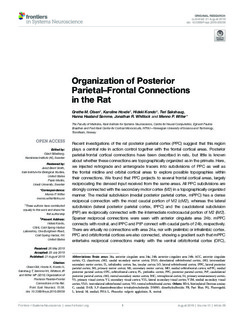| dc.contributor.author | Olsen, Grethe Mari | |
| dc.contributor.author | Hovde, Karoline | |
| dc.contributor.author | Kondo, Hideki | |
| dc.contributor.author | Sakshaug, Teri | |
| dc.contributor.author | Haaland Sømme, Hanna | |
| dc.contributor.author | Whitlock, Jonathan | |
| dc.contributor.author | Witter, Menno | |
| dc.date.accessioned | 2019-11-29T09:05:33Z | |
| dc.date.available | 2019-11-29T09:05:33Z | |
| dc.date.created | 2019-11-27T17:21:40Z | |
| dc.date.issued | 2019 | |
| dc.identifier.citation | Frontiers in Systems Neuroscience. 2019, 13 (38) | nb_NO |
| dc.identifier.issn | 1662-5137 | |
| dc.identifier.uri | http://hdl.handle.net/11250/2630976 | |
| dc.description.abstract | Recent investigations of the rat posterior parietal cortex (PPC) suggest that this region plays a central role in action control together with the frontal cortical areas. Posterior parietal-frontal cortical connections have been described in rats, but little is known about whether these connections are topographically organized as in the primate. Here, we injected retrograde and anterograde tracers into subdivisions of PPC as well as the frontal midline and orbital cortical areas to explore possible topographies within their connections. We found that PPC projects to several frontal cortical areas, largely reciprocating the densest input received from the same areas. All PPC subdivisions are strongly connected with the secondary motor cortex (M2) in a topographically organized manner. The medial subdivision (medial posterior parietal cortex, mPPC) has a dense reciprocal connection with the most caudal portion of M2 (cM2), whereas the lateral subdivision (lateral posterior parietal cortex, lPPC) and the caudolateral subdivision (PtP) are reciprocally connected with the intermediate rostrocaudal portion of M2 (iM2). Sparser reciprocal connections were seen with anterior cingulate area 24b. mPPC connects with rostral, and lPPC and PtP connect with caudal parts of 24b, respectively. There are virtually no connections with area 24a, nor with prelimbic or infralimbic cortex. PPC and orbitofrontal cortices are also connected, showing a gradient such that mPPC entertains reciprocal connections mainly with the ventral orbitofrontal cortex (OFC), whereas lPPC and PtP are preferentially connected with medial and central portions of ventrolateral OFC, respectively. Our results thus indicate that the connections of PPC with frontal cortices are organized in a topographical fashion, supporting functional heterogeneity within PPC and frontal cortices. | nb_NO |
| dc.language.iso | eng | nb_NO |
| dc.publisher | Frontiers Media | nb_NO |
| dc.rights | Navngivelse 4.0 Internasjonal | * |
| dc.rights.uri | http://creativecommons.org/licenses/by/4.0/deed.no | * |
| dc.title | Organization of Posterior Parietal–Frontal Connections in the Rat | nb_NO |
| dc.type | Journal article | nb_NO |
| dc.type | Peer reviewed | nb_NO |
| dc.description.version | publishedVersion | nb_NO |
| dc.source.volume | 13 | nb_NO |
| dc.source.journal | Frontiers in Systems Neuroscience | nb_NO |
| dc.source.issue | 38 | nb_NO |
| dc.identifier.doi | 10.3389/fnsys.2019.00038 | |
| dc.identifier.cristin | 1753359 | |
| dc.description.localcode | Copyright © 2019 Olsen, Hovde, Kondo, Sakshaug, Sømme, Whitlock and Witter. This is an open-access article distributed under the terms of the Creative Commons Attribution License (CC BY). The use, distribution or reproduction in other forums is permitted, provided the original author(s) and the copyright owner(s) are credited and that the original publication in this journal is cited, in accordance with accepted academic practice. No use, distribution or reproduction is permitted which does not comply with these terms. | nb_NO |
| cristin.unitcode | 194,65,60,0 | |
| cristin.unitname | Kavliinstitutt for nevrovitenskap | |
| cristin.ispublished | true | |
| cristin.fulltext | original | |
| cristin.qualitycode | 1 | |

